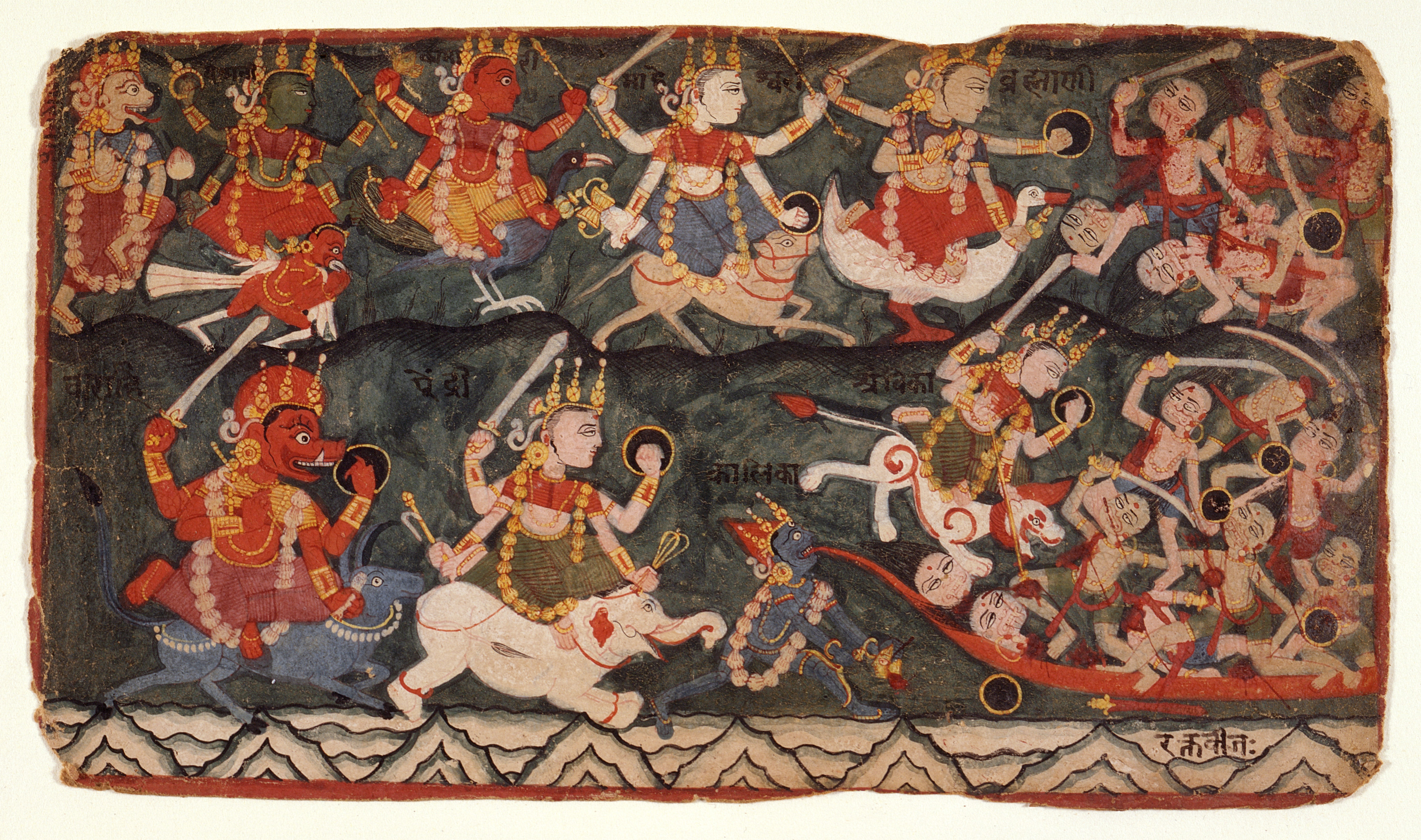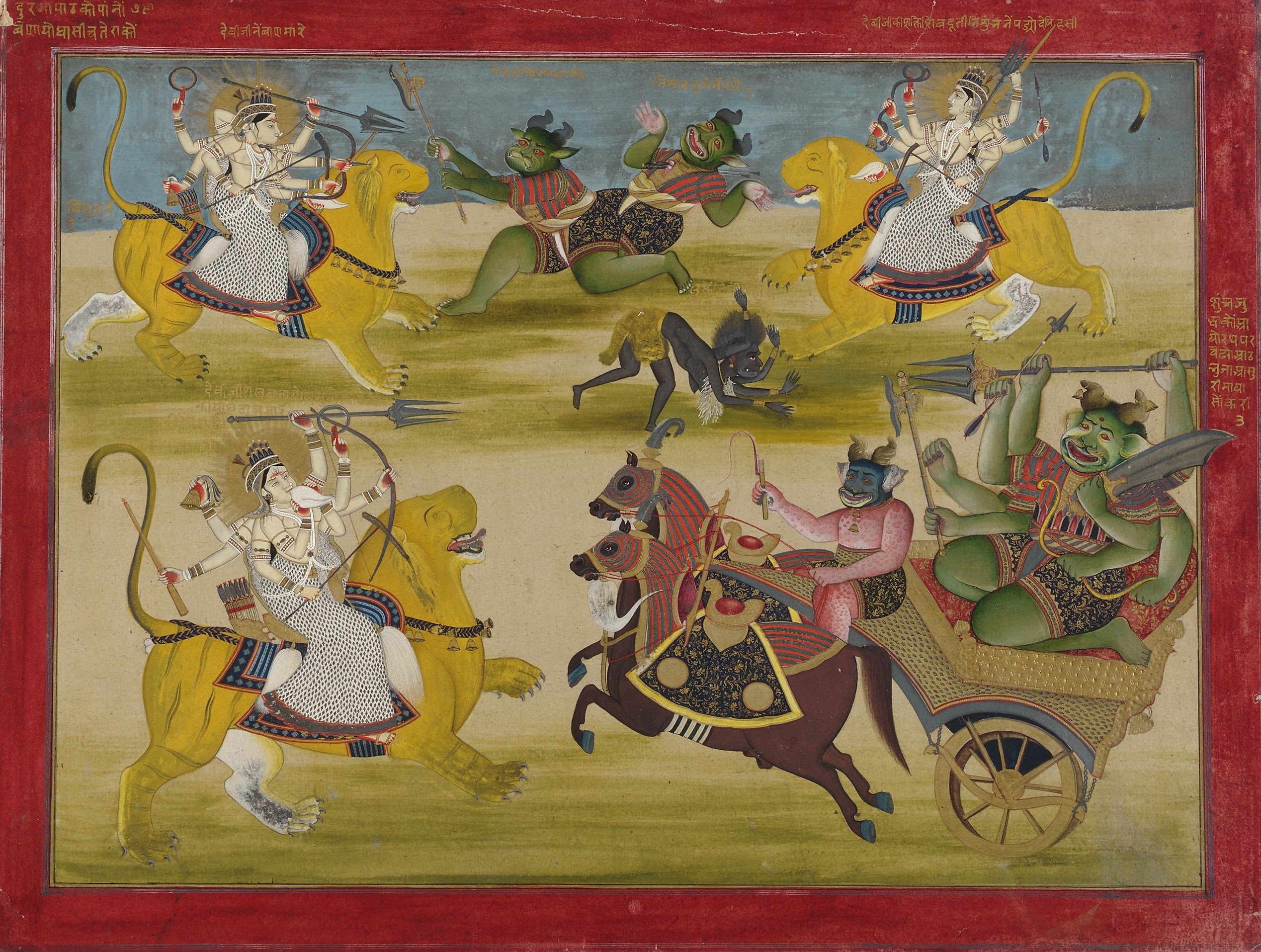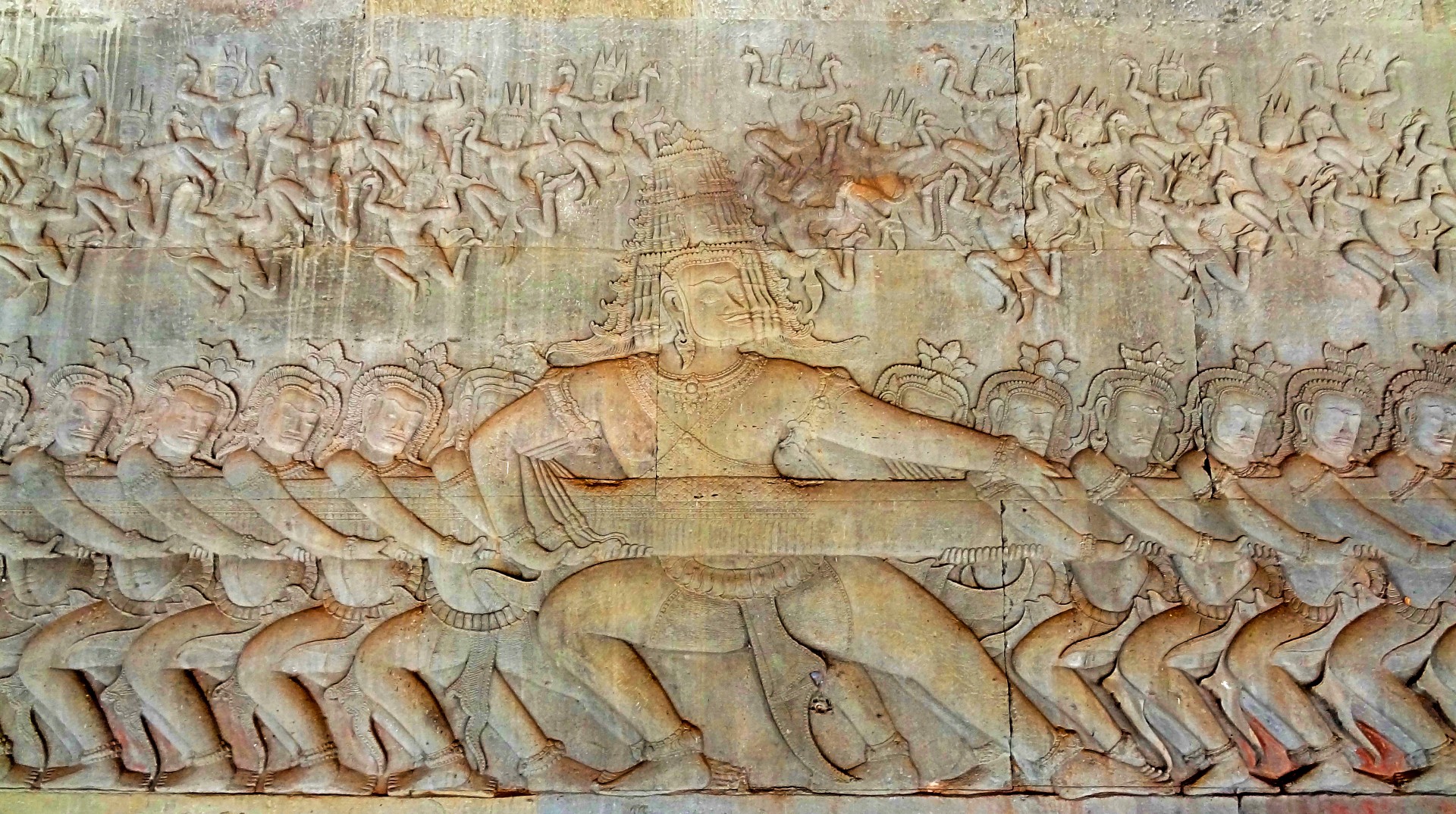|
Pratyangira
Pratyangira (, ), also called Atharvana Bhadrakali, Narasimhi, and Nikumbala, is a Hindu goddess associated with Shaktism. She is described to be the female energy and consort of Narasimha. According to the Tripura Rahasya, she is the pure manifestation of the wrath of Tripura Sundari. In the Vedas, Pratyangira is represented in the form of Atharvana Bhadrakali, the goddess of the Atharva Veda and magical spells. Narasimhi is part of the Saptamatrika mother goddesses. Legends There are many Hindu texts that narrate the different legends of Narasimhi. In a tale in the Devi Mahatmyam, Narasimhi was one of the Saptamatrikas, or one of the seven mother goddesses who were forms of the goddess Mahadevi. They had assembled to defeat the asuras Shumbha and Nishumbha, who had overrun Svarga (heaven). According to many ''Puranas'', at the end of the '' Krita Yuga'', a glittering spark appeared from the universe and transformed into a wicked demon named Vipulasura. Vipulasura disturbed a ... [...More Info...] [...Related Items...] OR: [Wikipedia] [Google] [Baidu] |
Matrikas
Matrikas (Sanskrit: मातृका (singular), IAST: mātṛkā, lit. "mothers") also called Mataras or Matri, are a group of mother goddesses in Hinduism. The Matrikas are often depicted in a group of seven, the Saptamatrika(s) (Seven Mothers). However, they are also depicted as a group of eight, the Ashtamatrika(s). In the '' Brihat Samhita'', Varahamihira says that "Matrikas are forms of Parvati taken by her with cognizance of (different major Hindu) gods corresponding to their names." They are associated with these gods as their energies (''Shaktis''). Brahmani emerged from Brahma, Vaishnavi from Vishnu, Maheshvari from Shiva, Indrani from Indra, Kaumari from Kartikeya, Varahi from Varaha and Chamunda from Chandi. And additionals are Narasimhi from Narasimha and Vinayaki from Ganesha. Originally the seven goddesses of the seven stars of the star cluster of the Pleiades, they became quite popular by the seventh century CE and a standard feature of the Hindu goddes ... [...More Info...] [...Related Items...] OR: [Wikipedia] [Google] [Baidu] |
Lakshmi
Lakshmi (; , , sometimes spelled Laxmi, ), also known as Shri (, , ), is one of the principal goddesses in Hinduism, revered as the goddess of wealth, fortune, prosperity, beauty, fertility, sovereignty, and abundance. She along with Parvati and Sarasvati, form the trinity of goddesses called the Tridevi. Lakshmi has been a central figure in Hindu tradition since pre-Buddhist times (1500 to 500 BCE) and remains one of the most widely worshipped goddesses in the Hindu pantheon. Although she does not appear in the earliest Vedic literature, the personification of the term '' shri''—auspiciousness, glory, and high rank, often associated with kingship—eventually led to the development of Sri-Lakshmi as a goddess in later Vedic texts, particularly the ''Shri Suktam''. Her importance grew significantly during the late epic period (around 400 CE), when she became particularly associated with the preserver god Vishnu as his consort. In this role, Lakshmi is seen as the ide ... [...More Info...] [...Related Items...] OR: [Wikipedia] [Google] [Baidu] |
Kaushiki
Kaushiki (,) is a Hindu goddess, a deity who emerged from the sheath of Parvati. She was created before Parvati's conflict with the asura brothers Shumbha and Nishumbha, and was also the reason the Matrikas come into existence. Legends Puranas The story of Kaushiki is described in Devi Mahatmyam of Markandeya Purana. The Devi Mahatmyam describes that the goddess Kaushiki appeared from the sheath (or ''kosha'') of the goddess Parvati’s body when the Deva (Hinduism), devas sang her praises after she defeated the Asura, asuras Shumbha and Nishumbha. Their eulogies that were intended to be a plea for help caused her to manifest from Parvati's form as a fair-skinned and bright being, earning the epithet 'Gauri'. The fact that she had been created from the cells of Parvati caused her to name herself Kaushiki, literally meaning 'woman of the cell'. With the fairness of her skin separated from her form, Parvati became dark-skinned and assumed the name of Kali. The deities went their sep ... [...More Info...] [...Related Items...] OR: [Wikipedia] [Google] [Baidu] |
Sanskrit
Sanskrit (; stem form ; nominal singular , ,) is a classical language belonging to the Indo-Aryan languages, Indo-Aryan branch of the Indo-European languages. It arose in northwest South Asia after its predecessor languages had Trans-cultural diffusion, diffused there from the northwest in the late Bronze Age#South Asia, Bronze Age. Sanskrit is the sacred language of Hinduism, the language of classical Hindu philosophy, and of historical texts of Buddhism and Jainism. It was a lingua franca, link language in ancient and medieval South Asia, and upon transmission of Hindu and Buddhist culture to Southeast Asia, East Asia and Central Asia in the early medieval era, it became a language of religion and high culture, and of the political elites in some of these regions. As a result, Sanskrit had a lasting effect on the languages of South Asia, Southeast Asia and East Asia, especially in their formal and learned vocabularies. Sanskrit generally connotes several Indo-Aryan languages# ... [...More Info...] [...Related Items...] OR: [Wikipedia] [Google] [Baidu] |
Tripura Rahasya
The Tripura Rahasya (Devanagari: त्रिपुरा रहस्य, ), also called the Haritāyana Samhitā, is a medieaval (11th-17th century CE) tantric Shakta Sanskrit text. The title has an ambiguous meaning, translated variously as ''The mystery beyond the three cities'', ''The mystery beyond the trinity'', or ''The secret of the supreme Goddess''. Tripura refers to the 'three cities' of consciousness, namely waking, dreaming and deep sleep, but also to the goddess Tripura Sundari, the prime consciousness underlying these three states. It details the path to liberation, as taught by Dattatreya to Parashurama. Nomenclatura Tripurā means "three towns" or "three places," or "the trinity." The three towns or states of consciousness are waking (Jāgṛat), dreaming (Svapna) and deep sleep (Suṣupti). The underlying consciousness of them all is called Tripura, the goddess Tripura Sundari. Rahasya means "secret" or "mystery," 'keeping secret', referring to the Sanskri ... [...More Info...] [...Related Items...] OR: [Wikipedia] [Google] [Baidu] |
Ashta Lakshmi
Ashta Lakshmi (Sanskrit: अष्टलक्ष्मी, IAST: Aṣṭalakṣmī; lit. "Octet of Lakshmi") or Ashtalakshmi, is a group of the eight manifestations of Lakshmi, the Hindu goddess of prosperity. She presides over eight sources of wealth: spirituality, material wealth, agriculture, royalty, knowledge, courage, progeny, and victory.Vasudha Narayanan in: John Stratton Hawley, Donna Marie Wulff p.104 The Ashta Lakshmi are always depicted and worshipped as an octet in temples.Flipside of Hindu Symbolism (Sociological and Scientific Linkages in Hinduism) by M. K. V. Narayan; published 2007 by Fultus Corporation; 200 pages; ; p.93 Iconography Adi Lakshmi Adi Lakshmi (Primeval Lakshmi) is portrayed to be the earliest forms of Lakshmi. Adi Lakshmi is the manifestation who supports a seeker to reach their source, or Atman. She is believed to proffer dhyana, a state of absolute silence, bliss, and peace. This aspect of the goddess is responsible for the furtherance in ... [...More Info...] [...Related Items...] OR: [Wikipedia] [Google] [Baidu] |
Krita Yuga
''Satya Yuga'' ( ''Krita Yuga'', IAST: ''Kṛta-yuga''), in Hinduism, is the first and best of the four ''yugas'' (world ages) in a '' Yuga Cycle'', preceded by ''Kali Yuga'' of the previous cycle and followed by ''Treta Yuga''. ''Satya Yuga'' lasts for 1,728,000 years (4,800 divine years). ''Satya Yuga'' is known as the age of truth, when humanity is governed by gods, and every manifestation or work is close to the purest ideal and humanity will allow intrinsic goodness to rule supreme. It is sometimes referred to as the "Golden Age". ''Dharma'' (depicted in the form of a bull) symbolizes morality and stood on all four legs during this period; the legs of ''Dharma'' reduce by one in each ''yuga'' that follows. As per Bhagavata Purana, the four legs of Dharma are , (or ), and . Etymology ''Yuga'' (), in this context, means "an age of the world", where its archaic spelling is ''yug'', with other forms of ''yugam'', , and ''yuge'', derived from ''yuj'' (), believed derive ... [...More Info...] [...Related Items...] OR: [Wikipedia] [Google] [Baidu] |
Puranas
Puranas (Merriam-Webster's Encyclopedia of Literature (1995 Edition), Article on "Puranas", , page 915) are a vast genre of Indian literature that include a wide range of topics, especially legends and other traditional lore. The Puranas are known for the intricate layers of symbolism depicted within their stories. Composed originally in Sanskrit and in Languages of India, other Indian languages,John Cort (1993), "An Overview of the Jaina Puranas" in ''Purana Perennis: Reciprocity and Transformation in Hindu and Jaina Texts,'' (Editor: Wendy Doniger), State University of New York Press, , pages 185-204 several of these texts are named after major Hindu deities such as Vishnu, Shiva, Brahma, and Mahadevi, Devi. The Puranic genre of literat ... [...More Info...] [...Related Items...] OR: [Wikipedia] [Google] [Baidu] |
Svarga
Svarga (, ), also known as Swarga, Indraloka and Svargaloka, is the celestial abode of the devas in Hinduism. Svarga is one of the seven higher lokas ( esoteric planes) in Hindu cosmology. Svarga is often translated as heaven, though it is regarded to be dissimilar to the concept of the Abrahamic Heaven. Description Svarga is a set of celestial worlds located on and above Mount Meru, where those who had led righteous lives by adhering to the scriptures delight in pleasures, before their next birth on earth. It is described to have been built by the deity Tvashtar, the Vedic architect of the devas. The king of the devas, Indra, is the ruler of Svarga, ruling it with his consort, Indrani. His palace in the abode is called Vaijayanta. This palace holds the famous hall, Sudharma, unrivalled among all the princely courts. The capital of Svarga is Amaravati, and its entrance is guarded by the legendary elephant, Airavata. Svarga is described to be the home of Kamadhenu, the c ... [...More Info...] [...Related Items...] OR: [Wikipedia] [Google] [Baidu] |
Sumbha And Nisumbha
Shumbha (शुम्भ) and Nishumbha (निशुम्भ) are two asuras in Hindu mythology, featured in the ''Devi Mahatmya''. In their legend, they were slain by the goddess Kaushiki. Legend The story of Shumbha and Nishumbha begins in the fifth chapter of the ''Devi Mahatmya''. Durga retells how two asura brothers sought to conquer the three worlds by subjecting themselves to severe penance and purification rituals so that no man or asura could destroy them. Shumbha and Nishumbha traveled to Pushkara, a sacred site, and remained there in prayer for ten thousand years. The creator deity Brahma saw the brothers' penance, and was pleased, granting them the boon they requested. Chanda and Munda, two lesser asuras in the service of Shumbha, encountered the goddess Durga, and were overwhelmed by her beauty. They carried reports of this goddess to Shumbha, who sought to possess Durga. Shumbha sent the asura Sugriva to court Parvati, but she rejected his advances. It was the ... [...More Info...] [...Related Items...] OR: [Wikipedia] [Google] [Baidu] |
Asura
Asuras () are a class of beings in Indian religions, and later Persian and Turkic mythology. They are described as power-seeking beings related to the more benevolent Devas (also known as Suras) in Hinduism. In its Buddhist context, the word is translated as "titan" or " antigod". According to Hindu texts, the asuras are in constant fear of the devas. Asuras are described in Indian texts as powerful superhuman demigods with good or bad qualities. In early Vedic literature, the good Asuras are called '' Adityas'' and are led by Varuna, while the malevolent ones are called '' Danavas'' and are led by Vritra. In the earliest layer of Vedic texts, Agni, Indra and other gods are also called Asuras, in the sense of their being "lords" of their respective domains, knowledge and abilities. In later Vedic and post-Vedic texts, the benevolent gods are called ''Devas'', while malevolent Asuras compete against these Devas and are considered "enem ... [...More Info...] [...Related Items...] OR: [Wikipedia] [Google] [Baidu] |








